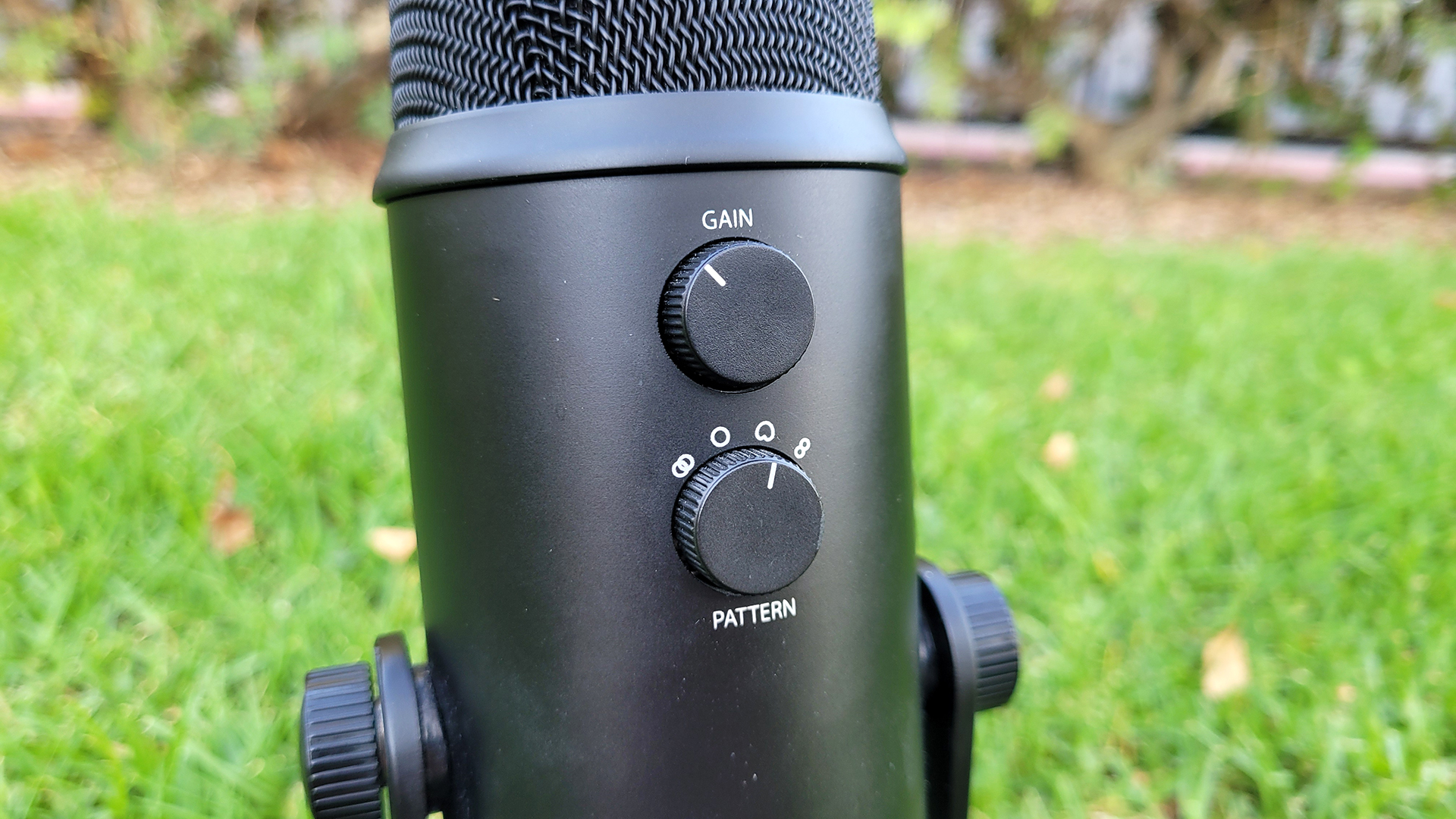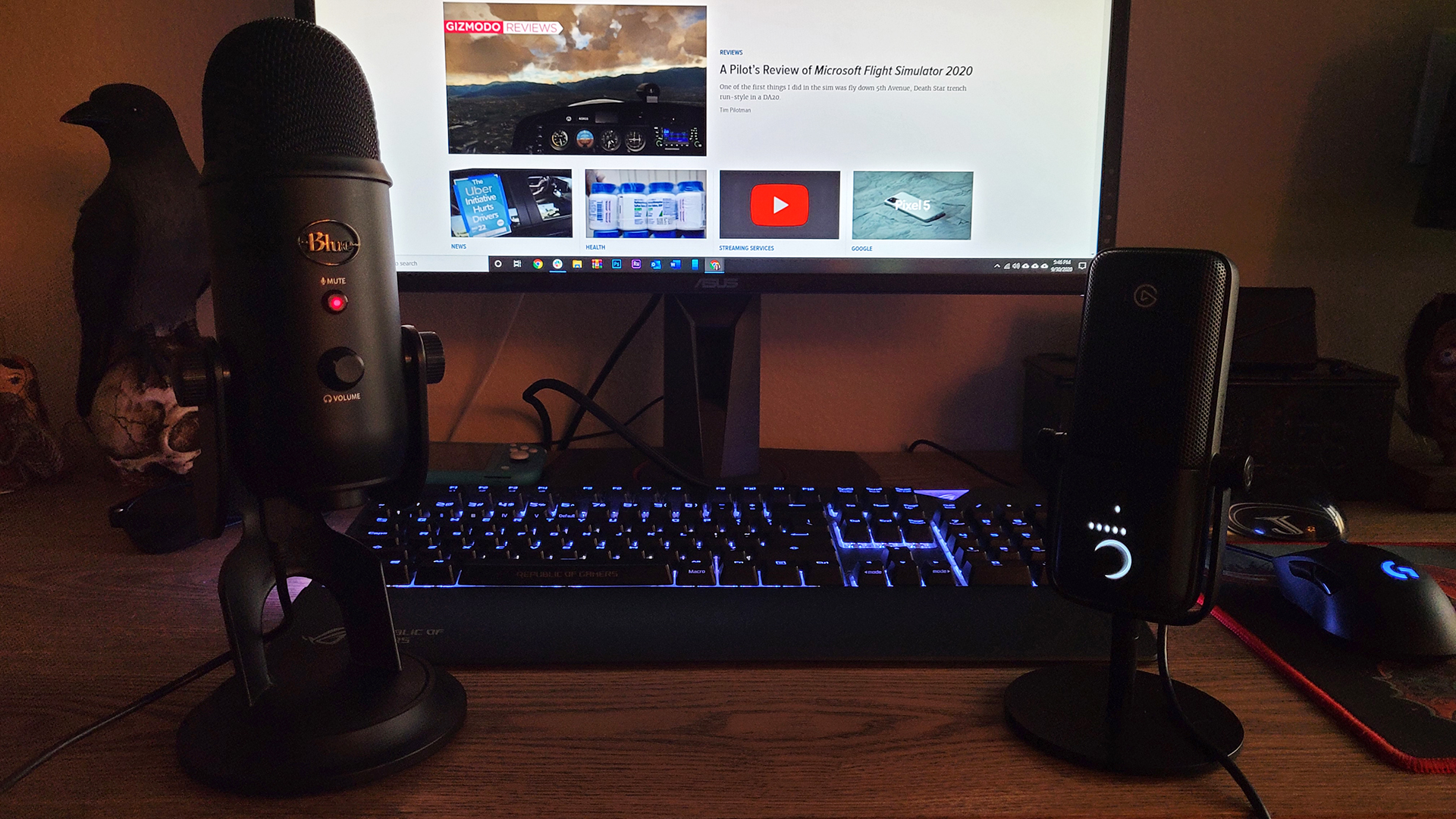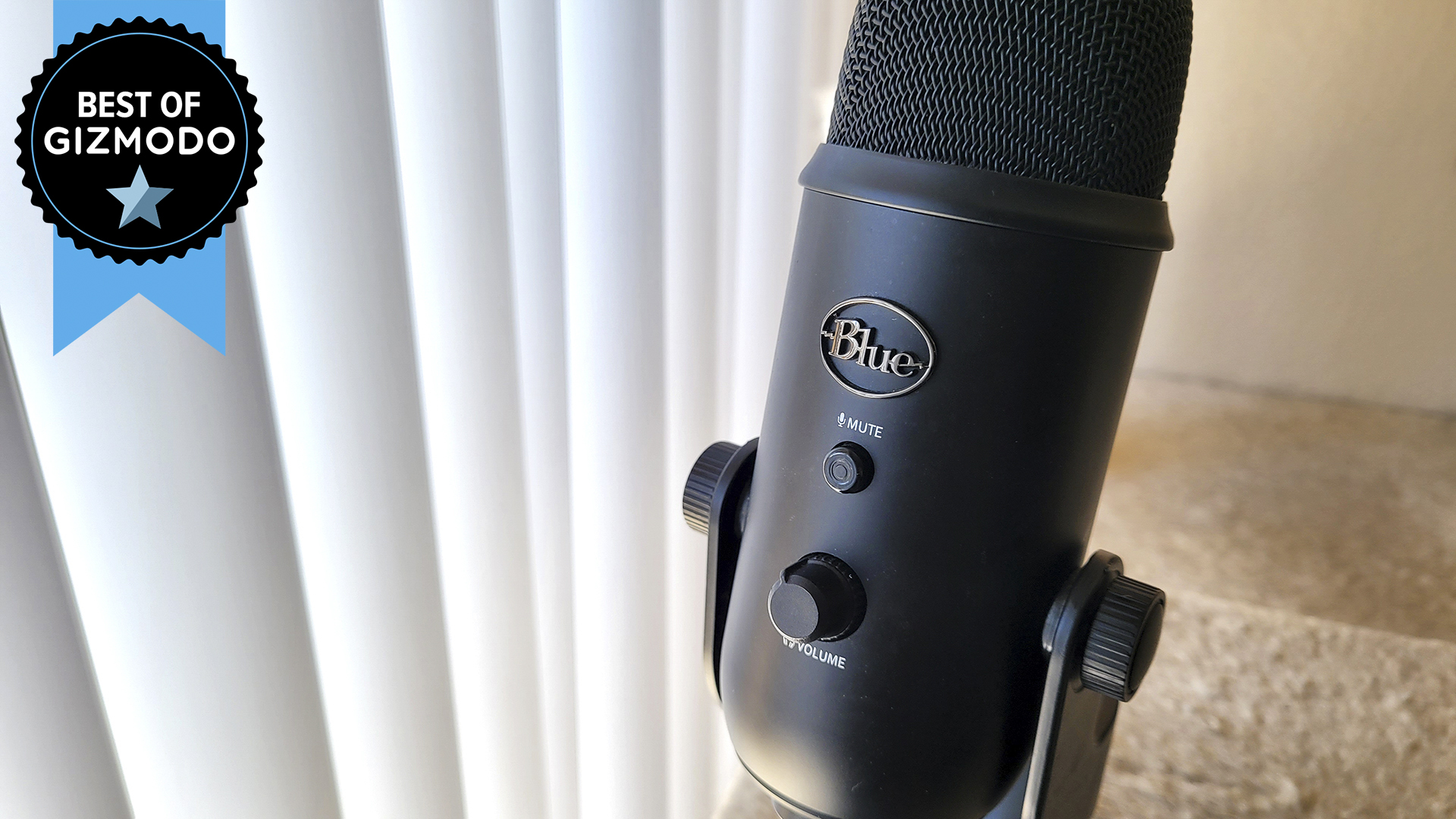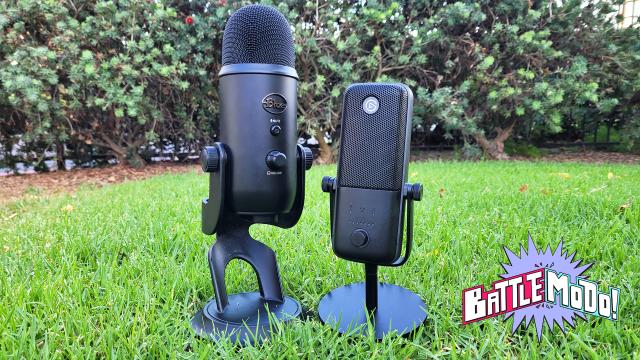USB mics were popular before the pandemic, especially among streamers and anyone who needed a high-quality microphone that was also easy to set up with their computer. But if you didn’t invest in a mic pre-lockdown and now find yourself needing a good one for meetings or that new podcast you and your friend are starting as a way to escape the loneliness of quarantine, the $200 Blue Yeti and $290 Elgato Wave 3 are two excellent choices. They’re so excellent you can’t go wrong with either, but we’re not here to say they’re both fine. We’re here to say which is the one you should actually spend your cash on.
Out of Blue’s entire USB mic line-up, the Yeti is by far the most popular. It earned THX certification all the way back in 2009, and the Yeti has made our “best of” lists in the past, too.
But the newer and slightly more expensive Wave 3 is a serious rival to the Yeti. It’s not THX-certified, but it probably should be — it has the same uncompromising quality to my ears. Elgato is known for making capture devices and a lot of different streaming equipment, like ring lights, stream decks, and green screens, but the Wave 3 is one of only two mics it makes at the moment. The $200 Wave 1 is priced the same as the Blue Yeti, which makes sense as they both have a sample rate of 48kHz. The Wave 3 can handle a sample rate up to 96kHz, which means it can theoretically capture more detail. It also has more granular controls than the Wave 1. For those reasons it seemed like a better mic to pit against the Blue Yeti.
For testing, I recorded myself reading a tiny portion of a novel, both with ambient fan noise in the background and without. I tested in the same room, my kitchen/dining area, which has a bit of natural echo to it. (Unfortunately, I could not unplug my fridge, so there’s still some ambient noise if you turn up the volume high enough.) The floor is hardwood and there’s no batting to muffle sound or trap frequencies, so all that combined together will give you a better idea of what these mics are capable of without a fancy set-up. I also tested some typing sounds with the mics placed in front of the keyboard and behind.
Features
You can select between four recording patterns by rotating a dial on the back of the Blue Yeti: Stereo, Omnidirectional, Cardioid, and Bidirectional. Depending on what you’re recording, one of these might be better than the rest. Cardioid is the best for recording podcasts because of its limited sound-directional range, while Omnidirectional is best for field recordings or live events where sound comes from multiple directions at once.
The gain is controlled by a separate dial, which lets you control how loud your voice sounds on the other end. The Yeti is a sensitive mic, and the gain has a wide-range, but depending on how you use the mic you probably will only need to set it once and then forget about it. Podcasts or Bidirectional recordings don’t need the gain turned up high, but outdoor recordings could probably benefit from having faraway sounds amplified, depending on the project.

Finally, the volume control and mute button are on the front of the mic. When the mic is muted, the red light in the centre of the small button will flash red. When it’s live, it’s a solid red. The button does wear out quickly, and when that happens you’ll have to press it a few times before it’s actually muted. But it stays muted once it is.
The Elgato Wave 3’s features are simpler, because the mic itself only records in a Cardioid pattern. Pushing the dial on the front switches between three modes: mic, headphone, and crossfade. With the mic setting enabled, the nob controls the gain. The headphone setting allows you to adjust volume, while the last mode lets you crossfade between your mic and PC audio mix, or select which sound source you want to come through the strongest. That works decently well.

There’s also a mute/unmute button on top that triggers with a light tap. It’s very sensitive, so the Wave 3 won’t pick up the sound of you tapping it. But it doesn’t always mute even if the red light is on. I learned this the hard way when I muted the mic to scold my cat, but everyone on the other end of the Zoom call could still hear me. I had to put my cat in front of my webcam so everyone could fawn over her. Definitely not an embarrassing moment, but it easily could have been. The Wave 3 also automatically lowers the gain sometimes if it senses it’s too high based on how you’re talking, but it seems like it won’t automatically raise it.
Even though the Wave 3 has that mic and PC audio mix feature over the Yeti, the Yeti is still the more versatile mic with more recording patterns, and a slightly greater range of control over the gain and volume. For those reasons, I have to give this category to the Yeti.
Winner: Blue Yeti
Recording
One of the Yeti’s biggest flaws is how much ambient noise it picks up, even if the Cardioid pattern is selected. Fans, street traffic, dogs barking, people talking outside a closed window — the Yeti loves to pick up a variety of noises, especially when I’m typing on a keyboard. I don’t have a mic arm, so I compensate by putting my keyboard behind the Yeti when I’m playing games and streaming, but the sounds of me furiously hitting WASD or clicking my mouse still come through.
In an ideal environment, like a sound-dampened room, using this mic for something like podcasting or video conferencing is perfect because of the professional-like quality you get at a fraction of the cost of other studio mics. But don’t expect magic if you’re sitting in a room with lots of hard services and ambient noise.
Still, the Yeti is one of the best stand-alone USB mics out there, even after years on the market. You might want to use a pop filter to soften any plosive sounds, like /p/, /b/, /d/, and /g/, because the Yeti is sensitive to those sounds, and if you are too close to the mic it will pick up the sound of the small bit of air you exhale as you make those sounds.
If you don’t have a sound-dampened room, don’t worry — get rid of ambient noise the best you can. The Yeti does a great job at eliminating most echo, especially in Cardioid mode, although like any USB mic I wouldn’t recommend recording anything in a room with a high, vaulted ceilings unless you want that sound effect.
When playing back audio recordings of myself reading from a book, the Wave 3 made me sound nearly identical to my recordings on the Blue Yeti. It has the same sensitivity to plosive sounds, echo-prone rooms, and ambient noise. But for a USB mic, it still records like a traditional, professional-grade mic. The Wave 3 pics up slightly more echo from my kitchen/dining area then the Yeti does (likely due to its higher sample rate), which gives the narration less of a warm tone. You can still hear my fridge humming away even in the “no ambient noise part,” but with a proper set-up, that won’t be an issue — or just record at a lower sample rate.
As long as you only need to record in Cardioid, you’ll get the same quality out of either mic. Sure, the Yeti has more patterns, but it’s only fair to test the recording quality of both in only the same pattern. And both the Yeti and Wave 3 nailed it.
Winner: Yeti
Size
One thing that has always bugged me about the Blue Yeti is the bottom padding. It doesn’t fully cover the underside of the base, so the mic can easily pick up desk vibrations. The nobs that tighten the mic so you can position it at what ever angle you choose easily loosen. And while the mic isn’t heavy, it’s much larger than the Wave 3 thanks to the giant base and stand that holds the mic up. But the large base makes it sturdy, so if you accidentally knock your hand into it, it will stop physically vibrating quickly.
Also, one benefit to the latter is that it stands up higher, so you don’t need a separate stand or arm to hold it close to mouth level. However, I am short, so this probably won’t apply to taller folks unless they lower their chairs all the way to the ground.

The Wave 3 is definitely the more portable of the two, though, thanks to its minimalist stand, which is a thin round base with a thin short post in the middle that holds up the entire mic. The entire bottom of the base is padded, too, so that minimizes any vibrations that could be picked up by the mic. Although because the stand doesn’t have as much structure to it as the Yeti’s does, the entire mic will physically vibrate longer than the Yeti.
The stand is also much shorter than the Yeti, so it obviously will not get anywhere near your mouth so it can pick up the crispest, cleanest sound. But the hinges are much sturdier than the Yeti; however you angle the mic, it will stay in place. The nobs don’t loosen all on their own.
Ultimately, the Wave 3 is a space-saver, has better hinges and nobs, and won’t look as bulky if you decide to hook it up to another mount compared to the Yeti. It’s also more aesthetically pleasing.
Winner: Wave 3
Winner

The Blue Yeti and Elgato Wave 3 are two really interesting mics to pit against one another. The Yeti, which has been around for almost 12 years, still holds incredible value in today’s USB mic space, largely due to its features, recording quality, and $200 price tag. The Wave 3 is a newcomer, having only been on retail shelves for a few months. It’s $90 more than the Yeti, and while it has less recording patterns, it still has a great recording quality and a more attractive design, plus a higher sample rate.
But the mic that will get you the most mileage for the price is the Blue Yeti. There’s a variety of third-party pop filters that are compatible with it, and of the two, it’s the most tried-and-tested mic. That’s not the say the Wave 3 isn’t an excellent mic. It is. It’s fantastic. But there can be only one winner of this Battlemodo, and that winner is the Blue Yeti.
